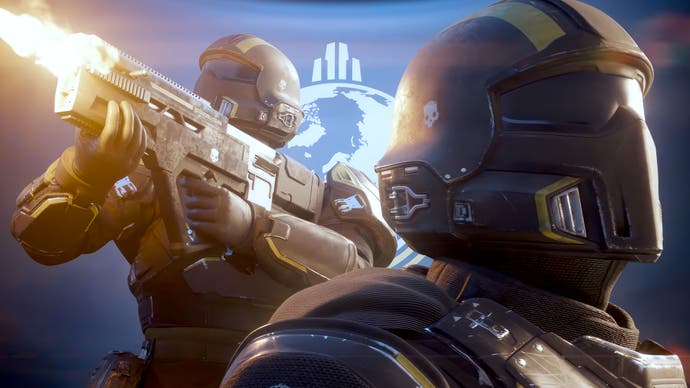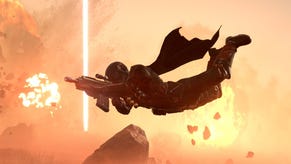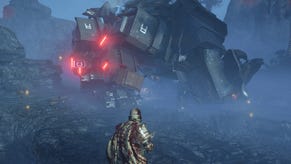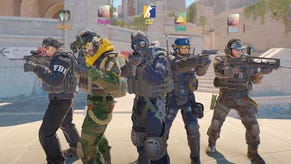Helldivers 2 delivers a solid, smooth experience on both PS5 and PC
30fps issues need addressing - while PC's lack of DLSS and FSR 2 is baffling.
Helldivers 2 is one of the most refreshing - and straightforward - multiplayer games I've played in a while. It's a third-person bug-shooting blitzkrieg, offering simple sets of objectives and a broad armament to help satisfy them. The actual action of defeating the game's foes is a lot of fun, with hordes of enemies to shoot into gibs with a four-person player squad. But does all that multiplayer chaos come with strings attached? Few games try to achieve destruction at this scale, especially factoring in the unpredictability of multiplayer gameplay, so what kind of visuals and performance should we expect in the game's console outing on PS5 and how does the quality of the PC port fare?
Visually, Helldivers 2 hardly advances the state of the art, but that's not to say that its visual make-up - and its environments - aren't compelling. There's a typical mix of modern graphical staples, but they are deployed effectively. Volumetric lighting is heavily used, for instance, with shafts of light shooting through rocks and trees. The quality level is high, presenting without obvious aliasing, even on the PS5 in its performance mode. The clouds are also volumetric in nature, at least at lower levels of the atmosphere, and resolve without distracting artifacting. Low-lying fog also appears to be part of the equation, with ground-level fog often giving planets a certain ethereal quality.
Environmental density is impressive. There's a lot of scattered rocks, shrubs, and tufts of grass throughout the various planets. Given the size and scope of the game I have to imagine that procedural systems have been used extensively here, but the final results look quite natural. Foliage in particular can be generously placed, with some especially verdant garden worlds. I did note animation issues with the foliage on at least one planet but on a more macro level, lighting and assets come together to make each world feel distinct, giving each environment some nice vistas.
Those small details contrast against the environment especially nicely because of the game's use of relatively high-resolution shadowmaps. Other elements of the lighting perhaps don't fare as well. The worlds are generally lit convincingly enough, but when you get up close you can spot some light leak in places, and shadowed regions tend to have a bit of a flat look. I'm not sure we're looking at pre-calculated, 'baked' lighting. I think instead we're seeing the typical mix of screen-space ambient occlusion and shadowmaps to shade in some of those finer details, which works well for the big picture stuff but doesn't hold up quite as well on close examination. The same can be said for reflections, which exhibit typical screen-space reflection 'skirting'.
After surveying the game's graphical tech, I wasn't quite sure what we were looking at. UE4 seemed like an obvious choice, but it didn't seem well-suited for this kind of big multiplayer game with open-world environments. Plus, some elements of the post-processing, like the screen-space reflections, didn't give very much of an Unreal impression to me. It turns out that the game is using a modified version of the discontinued Autodesk Stingray game engine, which makes more sense. A variant of this engine powered the excellent Warhammer 40K: Darktide, and while Helldivers 2 isn't quite as striking, I think the game looks strong overall.
But Environmental critiques are fine but perhaps miss the point: Helldivers 2 is an action-packed title, and much of your time is spent engaging with the game's insect and robotic foes. These firefights can look pretty extraordinary, especially when all four players are tightly clustered, trying to defend an objective. The key here is how enemies react when shot: each bullet strike spawns little bits of blood or smoke, alongside chunks of viscera or mechanical bits. It makes the simple act of firing at enemies satisfying.
We can actually blow away individual bits off each enemy, taking off limbs with small arms fire - or obliterating them with artillery fire. I loved the physics here - especially in aggregate, when the frame is just filled with physicalised objects, particles, and disintegrating enemies. Buildings can be destroyed in dramatic fashion when hit by airstrikes or blown up with a well-placed grenade, and the terrain deforms too under the barrage.
Helldivers 2 is a unique and visually interesting console title, so how do the performance and quality modes stack up? The most obvious split comes down to resolution. The performance mode runs at 1080p, while the quality mode steps up to approximately 1728p. Both modes counted at those figures in every shot I tested, so there are no signs of dynamic resolution as far as I can tell. In stationary shots, the difference between the two is obvious. Quality mode looks pretty clean and sharp, while the performance mode is very 1080p-like, with a visibly lower resolution - and with a lower-res HUD as well. On a 4K set, the performance mode doesn't look terribly clear, while the quality option tends to excel.
If you zoom in closely in the quality mode, you can notice slightly painterly image characteristics that suggest FSR 1 to my eyes, or a similar technique. Beyond the image clarity differences, the quality mode does have noticeably different-looking ambient occlusion, appearing darker and better defined, though I believe this is just a byproduct of the different rendering resolutions, at least judging from the PC build. There's also an anti-aliasing option, but I'm not sure what it's supposed to do as toggling it makes no difference. I'm not sure it's working at all, as the differences in using the same option on PC are obvious.

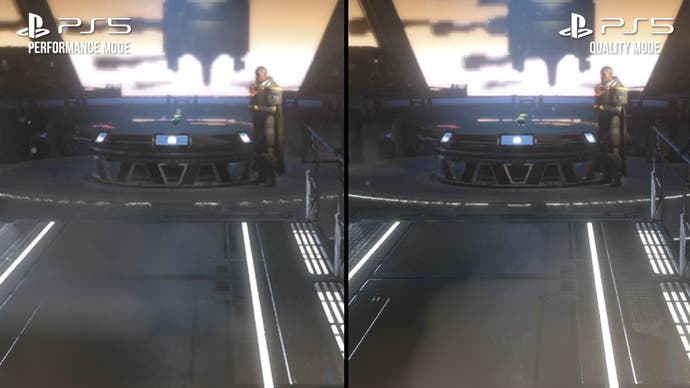
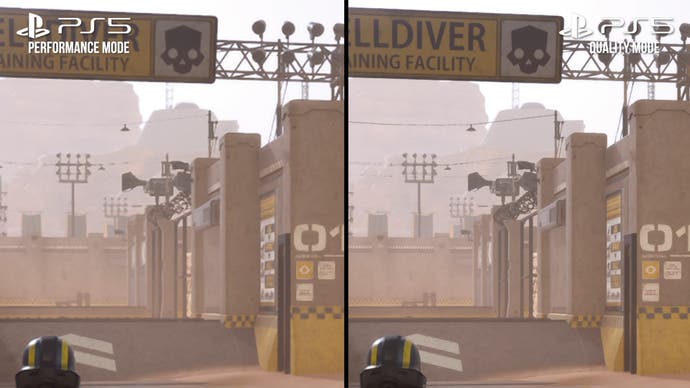
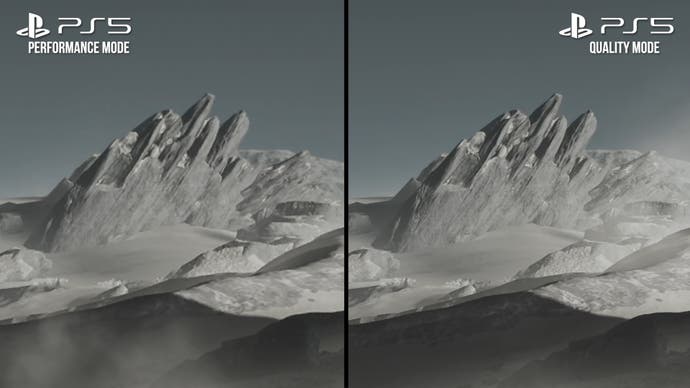
There's also a setting to adjust the level of image sharpening. At zero sharpening in performance mode Helldivers 2 looks soft and indistinct, while stepping up to the max sharpening level increases clarity at the cost of additional artifacting. Quality mode exhibits the same difference, although given its higher resolution, the effect is a bit more subtle.
Helldivers' performance mode runs smoothly. We're mostly at 60fps in typical play, with a very smooth readout, especially when combined with the game's motion blur. The game can suffer from extended dips into the 50s though, typically during larger firefights. In my gameplay the worst I saw was about 50fps, so the game does manage to stay pretty close to 60fps more generally, although it can spend a long time hovering in the 50s in extended firefights. The quality mode also manages a tight lock on its 30fps frame-rate target, but it clearly has issues with bouts of inconsistent frame-pacing. There are some genuine frame-rate drops in the mix, with the game dropping to the high 20s, although these aren't very common.
The PC version has a serviceable options menu with a typical range of selectables, including texture quality, shadow quality, volumetrics quality, and options for screen-space reflections and screen-space global illuminations. Sticking to the standard quality presets, low settings dramatically alters the terrain and decimates shadows and should really be avoided if at all possible. Medium makes the terrain match the collison, greatly improves shadow res, and adds TAA, ambient occlusion, and additional foliage. The high preset adds in more foliage and improves shadows, and the ultra preset looks very similar to high but with extra shadow detail. Performance-wise, there's a huge FPS boost by sliding down to the low preset, though the other presets are pretty similar in performance based on testing using an RTX 4090.
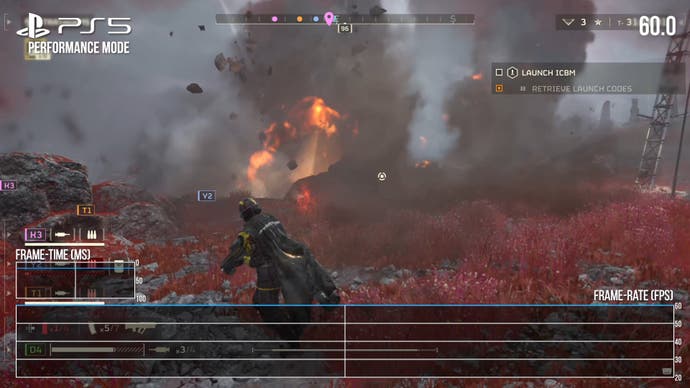



The various settings options mostly speak for themselves. There are two options of note though. The volumetric fog option seems to alter the resolution of the volumetric lighting in general, with lower resolution results at lower settings, while the anti-aliasing toggle actually does work properly on PC, completely turning off any AA treatment. It's weird that this setting doesn't do anything on PS5 but at least it functions as described on PC. However, the lack of any form of reconstruction option such as DLSS, XeSS or even FSR 2 is a real shame. Instead, a simple spatial upscaler is used, which bears the hallmarks of the OG FSR, just like PS5.
Unfortunately, the unexciting visual settings do mean that the upgrades over PS5 aren't as large as you might expect. There's little difference between the PC at max settings at 4K and the PS5 in its quality mode, absent some slightly higher resolution shadows and a bit of a cleaner image. It still doesn't provide a pristine image though and aliasing remains a significant problem. On a high-end system using a Ryzen 7 7800X3D with RTX 4090, we're typically looking at frame-rates in the 90s with settings fully maxed out at 4K resolution. That's solid performance, but you'd probably want to engage some amount of resolution scaling if playing on a high refresh rate display. Normally,toggling on DLSS would be a no-brainer, but of course temporal upscalers aren't supported in this game at the moment.
On a more mid-range PC (we looked at a Ryzen 5 3600 with RTX 2070 Super), we get decent enough performance, as long as we're willing to take a settings hit and move down to 1080p resolution on medium settings. Here, we're typically just above 60fps, and while this isn't enough to achieve super high frame-rates at a decent resolution, it's certainly capable of providing a good experience. Stuttering in-game isn't an option, but this seems to happen when launching into a match, but from there on out, gameplay is refreshingly smooth.
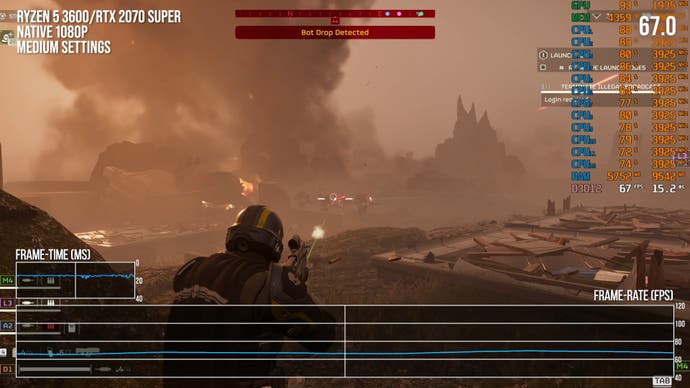

As a multiplayer experience, I think Helldivers 2 hits all the right notes. The gameplay basics are fun and the open-ended environments give you a fair amount of flexibility in how to tackle each objective. It seems like quite a tactical game too, though the need for advanced strategies wasn't too pressing at the lower difficulties I had the time to unlock. It doesn't seem terrifically complicated, nor does it come packaged with the kind of comprehensive content package that modern players often expect, but I think those omissions are more than forgivable at its asking price.
The special abilities the game provides, combined with friendly fire (which is enabled at all times) is a recipe for a lot of squad-based fun with friends. There are echoes of other PvE shooters here - namely of the extraction shooter variety, though Mass Effect 3's multiplayer also came to mind - but this game seems more oriented around having fun than creating a tightly crafted competitive experience. It's still a tense, communication-based game, but it feels designed to generate memorable gameplay - and I think it succeeds.
Both the PS5 and PC versions of Helldivers 2 provide a good experience, and the game is attractive enough for a large-scale multiplayer shooter. I would like to see some additional features on PC though: temporal upsamplers are a must-have in my opinion, and frame generation would be great as well. The 1080p resolution on PS5 in performance mode is bound to be a source of controversy too, but I think it's a sensible trade-off given how taxing this game can be. Perhaps experimentation with FSR 2 might yield decent results, especially considering the unimpressive quality of the existing TAA, but this is a tough game to run at high resolutions. So Helldivers 2 is a compelling multiplayer package, and it's technically sound as well. Players looking for a fresh co-op experience are unlikely to be disappointed.
